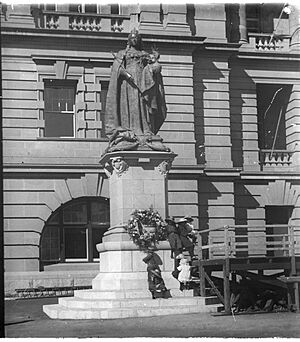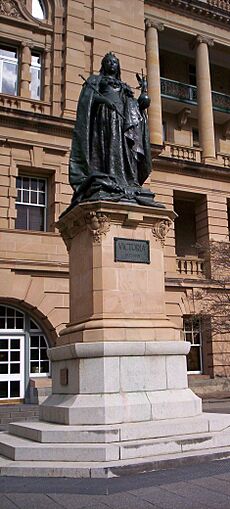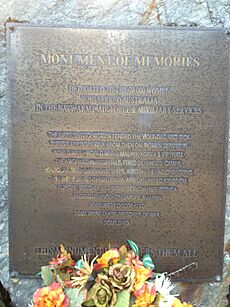Queens Gardens, Brisbane facts for kids
Quick facts for kids Queens Gardens, Brisbane |
|
|---|---|

Queens Gardens, looking to the statue of Queen Victoria and the former Land Administration Building (now Heritage Hotel), 2017
|
|
| Location | 144 George Street, Brisbane CBD, City of Brisbane, Queensland, Australia |
| Design period | 1900–1914 (early 20th century) |
| Built | c. 1905–1990s |
| Official name: Queens Gardens, Executive Gardens, St Johns Church Reserve | |
| Type | state heritage (built, landscape, archaeological) |
| Designated | 21 October 1992 |
| Reference no. | 600112 |
| Significant period | 1820s–1830s, 1848–1899, 1901–1962, (historical) |
| Significant components | lake / pond / waterway, post/s – lamp, tree groups – avenue of, lawn/s, statue, seating, memorial – rock/stone/boulder, garden – bed/s, pathway/walkway, trees/plantings, guns/weaponry/armament |
| Lua error in Module:Location_map at line 420: attempt to index field 'wikibase' (a nil value). | |
Queens Gardens is a special park in the heart of Brisbane, Queensland, Australia. It's located between George Street, Elizabeth Street, and William Street. This park has a long history, dating back to the early 1900s, and is also known as Executive Gardens or St Johns Church Reserve. It was added to the Queensland Heritage Register in 1992 because of its importance.
The park is right next to some important buildings. These include the old Land Administration Building (now the Heritage Hotel) and the former Treasury Building (now the Treasury Casino). Across the street, you can also see the Old State Library Building.
Contents
The History of Queens Gardens
From Penal Colony to Park
The area where Queens Gardens now stands has a very old past. When Brisbane was first a penal colony (a place where prisoners were sent), this site was home to a small cottage, a lumber yard, and workshops. It was a busy place for the early settlement.
The park we see today was created in different stages, starting around 1905 and continuing until the 1960s. This land has always been important, first for the convict settlement and later for the Church of England in Queensland.
One of the first buildings in Brisbane Town was a wooden cottage. It stood on part of the park's site, near William and Elizabeth Streets. Around 1825, a lumber yard was built here, holding tools and workshops. Later, the lumber yard moved, and the cottage became offices. The part of the park along George Street was once a chaplain's garden.
The Church Era
In 1848, the Church of England took over the site. They built a parsonage (a house for a priest) in 1850–1851. St John's Church was also built on the site between 1850 and 1854. It was made bigger in 1868, and a separate bell tower was added in 1877. A building for a church school and library was built in 1879–1880.
In the 1880s, the Church planned for a large cathedral here. A new Church Institute and Synod Hall was built in 1897. However, the government wanted to buy the land for new buildings. After some discussions, the government bought the church square in 1899.
Becoming a Public Garden
In 1901, the Church Institute building was used by the Police Department. Later, it became offices for the Criminal Investigation Branch.
By 1904, the old church, bell tower, school, and parsonage were taken down. A strip of land between William and George Streets became the "Executive Gardens."
A bronze statue of Queen Victoria was put up in the park in mid-1906. It was a copy of a statue in England. People in Queensland helped pay for it, showing their loyalty to the British Empire. The statue's base was designed by the Public Works Department and built by a local stonemason, William Kitchen.
On Empire Day, soldiers who fought in wars like the Crimean, Sudan, and South African wars would gather here. The park became known as Queens Gardens and was a meeting spot for important state events. This statue is still the only one of Queen Victoria in Brisbane.
In late 1906, the park was made larger, including the area where the parsonage used to be.
In 1917, a Krupp 77mm field gun was placed in the gardens. This gun was captured from the German army in France during World War I. It was a gift from King George V and given to Queensland by Lord Kitchener. This happened at the request of Thomas Joseph Ryan, who was the Queensland Labor Premier from 1915 to 1919.
A bronze statue of TJ Ryan was also put in the gardens in 1925. It was designed by Australian sculptor Bertram MacKennal and paid for by public donations.
In 1962, the old CIB building was taken down, and the park grew to cover the entire square. A new design for the gardens was made for the visit of Queen Elizabeth II to Brisbane in March 1963. Harry Oakman, a landscape architect, designed the new look for the park.
In 1990, the Queensland Service Women's Association put up a "Monument of Memories" in the park. It honors the 70,000 Australian women who served in the military.
What You Can See in Queens Gardens
Queens Gardens is a public park shaped like a square. It's surrounded by William, Elizabeth, and George Streets. On one side is the old Lands Administration Building (now the Heritage Hotel). Other important buildings nearby include the Treasury Building (now the Treasury Casino), the Old State Library, and the Family Services Building.
The park has a few main parts:
- An asphalt area in front of the Lands Administration Building connects George and William Streets.
- A path cuts diagonally from one corner to the center of the asphalt area.
- A large grassy lawn is bordered by Elizabeth Street, the diagonal path, and garden beds.
- There's a lily pond near where the diagonal path meets the asphalt area. Next to the pond is an old fountain, now a planter box.
- The diagonal path has a line of colvillea trees. A coral tree marks the entrance from George Street.
Most of the plants in the park are kept low so you can see across the whole space. There are hedges along George Street and a fence with a hedge along William Street.
Even though the park's design is fairly new, it still has older monuments that connect it to its past. Two bronze statues on stone bases are still in their original spots. A special marble slab in the paved area shows where the altar of the old St John's Pro-Cathedral used to be.
The statue of Queen Victoria is in the middle of the asphalt area, facing the Lands Administration Building. The diagonal path leads right to it. Behind the Queen's statue is the 1915 Krupp gun. The Queen's statue stands on a base made of brown Helidon sandstone and Enoggera granite.
The TJ Ryan statue also stands on a base of Helidon sandstone and Enoggera granite. It's a bit separate from the main park area, facing the corner of William and Elizabeth Streets.
A newer memorial in the park is a rough bluestone block with a bronze plaque. It honors Australian women who served in wars. You can find it near some rose beds.
You'll also find wooden and concrete benches along the paths and around the lily pond. The old cast-iron lamp posts have been moved to line the paths. The gardens feature many colorful and interesting plants. Many garden beds have plants clipped into cool geometric shapes.
The Gardens offer a great view of the important buildings around them, making the area a pleasant place to visit.
Why Queens Gardens is Special
Queens Gardens was added to the Queensland Heritage Register in 1992 because it meets several important rules.
- It shows how Queensland's history has changed.
Queens Gardens helps us understand Queensland's history. It shows how the site changed from a convict area to a church center, and then to a public park. The statues of Queen Victoria and TJ Ryan also show important historical connections.
- It can teach us more about Queensland's past.
The site might still hold clues underground from the 1820s. These clues could help us learn more about how early European settlements in Queensland were built.
- It shows a special type of design.
The current design of the garden is a great example of the work of Harry Oakman, a famous landscape architect. It's one of his best-preserved designs in Brisbane.
- It looks beautiful.
The gardens, along with the Queen Victoria and TJ Ryan statues, are very beautiful. They make the area around the important government buildings look wonderful, and people in the community really value them.
- It has a special link to important people or groups.
The site has a strong connection to the Anglican Church and its early history in Queensland.







